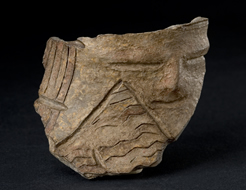|
||||||||||||||||||||||||||||||||
|
|
Museum of: Budapest | |||||||||||||||||||||||||||||||
| Name of the artefact: Fragment of faced pot | ||||||||||||||||||||||||||||||||
|
Representation of Human face on the lip of a vessel
from Neolithic |
||||||||||||||||||||||||||||||||
|
WHERE IS IT AND MAIN
CHARACTERISTICS |
STATE |
|||||||||||||||||||||||||||||||
|
Department: |
Prehistoric Department |
Preservation: |
Very good | |||||||||||||||||||||||||||||
|
Inventory number: |
GY/520 |
Restauration: |
Restored | |||||||||||||||||||||||||||||
|
Name of the artefact: |
Fragment of faced pot |
Completeness: |
Incomplete | |||||||||||||||||||||||||||||
|
Object type: |
Vessel/Anphora |
|||||||||||||||||||||||||||||||
|
Material: |
Clay |
|||||||||||||||||||||||||||||||
|
Methof of manufacture: |
Hand made<< |
|||||||||||||||||||||||||||||||
|
Decoration
type: |
Incision |
|||||||||||||||||||||||||||||||
|
Distinctive mark: |
Incised "M" -shaped line framing the
face |
|||||||||||||||||||||||||||||||
|
DIMENSIONS |
PERIOD OF USE |
|||||||||||||||||||||||||||||||
|
Length (mm): |
80 mm |
Epoque: |
Neolithic |
|||||||||||||||||||||||||||||
|
Heigth
(mm): |
- |
Culture: |
Transdanubian Linear Pottery
Culture |
|||||||||||||||||||||||||||||
|
Diameter
(mm): |
- |
Period: |
Middle<< |
|||||||||||||||||||||||||||||
|
Width (mm): |
67 mm |
Face: |
Zselíz |
|||||||||||||||||||||||||||||
|
Thickness (mm): |
3 mm |
Absolute chronology: |
4700-4600 BC |
|||||||||||||||||||||||||||||
|
Weight
(g): |
- |
|||||||||||||||||||||||||||||||
DISCOVERY |
||||||||||||||||||||||||||||||||
|
Date: |
2003 |
Country: |
Pest |
|||||||||||||||||||||||||||||
|
District: |
- |
Town hall affiliation: |
Budapest |
|||||||||||||||||||||||||||||
|
Village: |
Biatorbágy |
Discovery findspot: |
Biatorbágy, Hosszúrétek |
|||||||||||||||||||||||||||||
|
Condition of discovery: |
Archaeological excavation |
Discovery type: |
Pit |
|||||||||||||||||||||||||||||
|
ANALYSES DETERMINATIONS |
FILLED IN BY |
|||||||||||||||||||||||||||||||
|
Type: |
- |
Name: |
László András Horváth |
|||||||||||||||||||||||||||||
|
Laboratory: |
- |
Institution: |
Budapest History Museum |
|||||||||||||||||||||||||||||
|
No./Code: |
- |
Date: |
21/01/2006 |
|||||||||||||||||||||||||||||
|
DEEPENINGS |
||||||||||||||||||||||||||||||||
|
Morphology of the object: |
||||||||||||||||||||||||||||||||
|
The fragment of a vessel of a slightly outverted neck
with the representation of a human face. |
||||||||||||||||||||||||||||||||
|
Decoration: |
||||||||||||||||||||||||||||||||
|
The vessel was decorated with bunches of densely
incised, usually thin lines. The spaces between the lines were partly
polished and partly painted with red or yellow pigment. The face depicted
with plastic and incised lines is closed with an M-shaped pattern at the
bottom, which is filled in with densely incised zigzag patterns. Another
similar ornament starts in the height of the eyes, the design of which
cannot be observed on the small fragment. |
||||||||||||||||||||||||||||||||
|
Inscription: |
||||||||||||||||||||||||||||||||
|
- |
||||||||||||||||||||||||||||||||
|
Analogies: |
||||||||||||||||||||||||||||||||
|
Biatorbágy-Tyúkberek 36. gödör (M. Virág Zsuzsa 1998,
Abb. 7, 1); Törökbálint-Dulácska 157. gödör (M. Virág Zsuzsa 1998, Abb.
2-4); Mula-Čenkov (Kuzma, I.: Plastika elieovskej skupiny z
Mule-Čenkova (Plastik der eliezovce-Gruppe aus Mula Čenkov). Slovenska
Archaeologica 38(1990) 429-452., Obr. 3; Obr. 4. 3-5; Obr. 5.) |
||||||||||||||||||||||||||||||||
|
Interpretation: |
||||||||||||||||||||||||||||||||
|
It is difficult to tell from the fragment if it came
from a face-pot or a vessel representing a seated man. Its function,
however, is the same in either case. These vessels could be cult
paraphernalia, most probably of the crop cult. They contained the crop
with which the fertility magic was performed next year before the start of
the agricultural work. |
||||||||||||||||||||||||||||||||
|
Bibliography: |
||||||||||||||||||||||||||||||||
|
Virág 1998: Zs. M. Virág: Neuere anthropomorphe
Darstellungen der Linienbandkeramik aus der Umgebung von Budapest. In: (F.
Drasovean, ed.): The Late Neolithic of the Middle Danube Region.
International Symposium on the Problems of the Transition from Middle to
Late Neolithic in the Middle Danube Region. June 1997, Timisoara, Romania.
Timisoara 1998. |
||||||||||||||||||||||||||||||||

